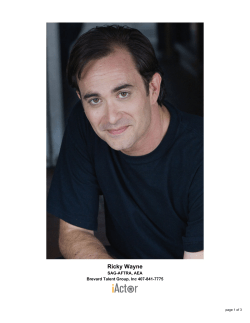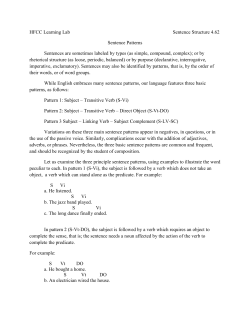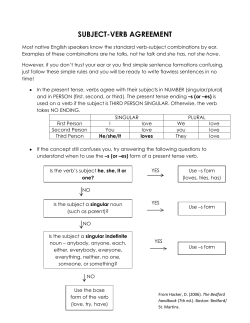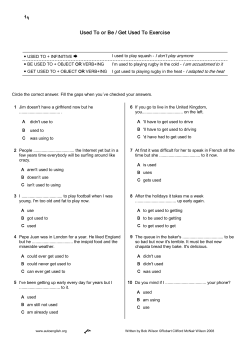
V-X or what is it to be a suffix?
V-X or what is it to be a suffix? İsa Kerem Bayırlı, Boğaziçi University Suffixal status of a morpheme is generally taken to be morphological information that is specified in the lexicon. Functional morphemes are argued to have lexical specifications that determine whether they show affixal character or not (Lieber, 1980, Baker, 1988, i. a.). In this talk, I would like to raise the question of whether “suffix” is a primitive lexical object (as the claims above make it to be) or a derivative object (derivative of a configurational pattern). Is suffixal status of a morpheme idiosyncratic or is it predictable (from its syntactic positioning)? I will try to answer this question based on data from Turkish. Consider the tables below: Table 1. Existent Structures Non-existent Structures Glosses Suffixation Free Morphemes Verb-PAST gel-di *gel di Verb-COND gel-se *gel se Verb-PROG gel-iyor *gel iyor Verb-FUT gel-ecek *gel ecek Verb-PERF gel-miş *gel miş Verb-AOR gel-ir *gel ir Verb-NEG-PAST gel-me-di *gel me-di In the table above, we see that the functional morpheme above the verb is always a suffix on the verb and it is never a head-final free morpheme. Now consider also the case with the verbal negation. Table 2. Existent Structures Non-existent Structures Glosses Suffixation Free Morphemes Verb-Verb.NEG-PAST gel-me-di *gel-me di Verb-Verb.NEG-COND gel-me-se *gel-me se Verb-Verb.NEG-PROG gel-mi-yor *gel-mi yor Verb-Verb.NEG-FUT gel-me-yecek *gel-me yecek Verb-Verb.NEG-PERF gel-me-miş *gel-me miş Verb-Verb.NEG-AOR.AGR gel-me-z *gel-me z The negation morpheme is verbal in the sense that it shares the same environment with the verb. Table 2 shows that when there is a morpheme above the verbal negation, it is also a suffix and never a free morpheme. The examples in the tables seem to suggest a constraint that I will call “V-X”. This constraint says that the functional morpheme immediately above a verbal root or verbal stem has to be a suffix on this verbal item. For head-final languages, it predicts that the functional morpheme above the verbal item can never be a free morpheme following it. Assuming that the constraint above is right, the question is which model can capture it without auxiliary assumptions (other than those imposed by phrase structure itself). Head-directionality approach is weak in the sense that without any auxiliary assumptions, it does not make any prediction about bound versus free status of functional morphemes. There is no principled reason why there should not be a functional morpheme which is right above the verb and which is free. Following Ulutaş (2006), it may be argued that there is (always) overt movement of the verb to the next head up because this higher head always have “uninterpretable V feature”. And head-to-head adjunction (as a result of this movement) is a structure that is interpreted as suffixation (for the latter claim, Julien, 2002, i. a.). Here suffixation is again a reflex of syntax. However, this position has two problems. 1) If having “uninterpretable feature” is an aspect of the functional heads, one would in principle expect some variation among functional heads in having this feature or not. That all of the functional heads in Turkish have “uninterpretable V feature” is surprising. 2) What determines the category of the “uninterpretable feature”? Why is it the case that “uninterpretable feature” is V but not N? This seems to have something to do with the fact that these functional morphemes always c-selects for a VP. This direct relation between the category of the “uninterpretable feature” and c-selectional facts of the functional head is obscured in the explanation above. In this sense, this explanation misses some generalization. I will instead adopt Brody’s Mirror Theory (1997, 2003 i. a.) with an antilexicalist reading. Brody argues for Telescope Hypothesis, which indicates that “a single copy of a lexical item can serve both as a head and as a phrase” (Brody: 2003 : 216), which gives us the structure below: As a consequence of Telescope Hypothesis, in this tree “I” replaces I-I’IP, “v” replaces v-v’-vP and “V” replaces V-V’-VP projection lines. Phrasal relations are captured in the specifier position (here object and subject ( and its trace)). As for head-chains, Brody (2003: 218) argues for Mirror (Hypothesis), which is “the syntactic relation ‘X complement of Y’ is identical to an inverse-order morphological relation ‘X specifier of Y’”. More informally, in a complementation relation (say, between I v and V), the morphological order of heads is the inverse of their syntactic order (that is, V-v-I as in “love-s”). For Brody, Mirror is a licensing relation between lexicon and syntax. My position is antilexicalist in the sense that I take Mirror to be a spell-out mechanism from syntax to PF. This position makes it possible to capture suffixation as a reflex of syntax without resorting morphological information in the lexicon. Turkish verbs (and verbal suffixes) seem to form head-relations rather than phrasal relations. A. They cannot move to the specifier of question head (unlike phrases) (1.a) *gel mi di-n? (1.b) *gel-me mi di-n? come Q PAST-2SG come-Verb.NEG Q PAST-2SG B. As noted in Kornfilt (1996), they cannot be coordinated (unlike phrases) (2.a) *gel ve git-ti-n (2.b.) *gel-me ve git-me-di-n come and go-PAST-2 come-Verb.NEG and go-Verb.NEG-PAST-2SG If verbs and verbal stems do not form phrasal chains, they cannot be specifiers. They must occupy head-positions. Then, their representation is as in (3) and not as in (4): √(3) *(4) X X V V (where X is any functional morpheme syntactically right above the verb). Via Mirror, (3) has to be “realized” as V-X where X is suffixed to V (Note that V can be a verb or a verbal suffix). This captures V-X generalization by making reference only to phrase structure. The observation V-X is a consequence of the fact that verbal items cannot behave as a phrase. This means that it is something about the verb that causes suffixation and this explains why functional heads do not show variation in having uninterpretable feature. Note that in this explanation, c-selection is the only assumption required to understand the interaction of the verb with the functional morpheme above it. Questions about uninterpretable features do not even arise. The conclusion: A subclass of the object called suffix is a reflex of configuration and not a lexical primitive. It is, therefore, probably not part of language knowledge. References Brody, M. (2003). Towards An Elegant Syntax. London: Routledge. Baker, M. (1988). Incorporation: A Theory of Grammatical Function Changing. The University of Chicago Press. Chicago and London. Julien, M. (2002). Syntactic Heads and Word Formation. Oxford University Press. New York. Kornfilt, J. (1996). On some copular clitics in Turkish. ZAS Papers in Linguistics 6. Lieber, R. (1980). On the Organization of the Lexicon. Doctoral thesis, MIT. Ulutaş, S. (2006) Verb Movement and Feature Percolation: Evidence from Turkish Relative Clauses. MA Thesis. Bogazici University.
© Copyright 2025


















